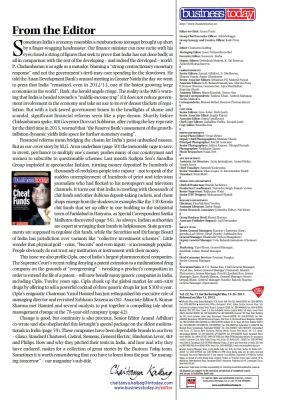Cheat Funds
[Business Today]
Published date: 26th May 2013
Sometimes India’s economy resembles a rambunctious teenager brought up short by a finger-wagging headmaster. Our finance minister can now recite with his eyes closed a string of figures that seek to prove that India has not done badly at all in comparison with the rest of the developing and indeed the developed – world. P. Chidambaram is as agile as a matador, blaming a “strong contractionary monetary response” and not the government’s devil-may-care spending for the slowdown. He told the Asian Development Bank’s annual meeting in Greater Noida the day we went to press that India “remained, even in 2012/13, one of the fastest growing large economies in the world”. Hark, the herald angels cringe. The reality is the IMF’s warning that India is headed towards a “middle-income trap” if it does not reduce government involvement in the economy and take an axe to its ever denser thickets of regulation. But with a lock-jawed government frozen in the headlights of shame and scandal, significant financial reforms seem like a pipe dream. Shortly before Chidambaram spoke, RBI Governor Duvvuri Subbarao, after cutting the key repo rate for the third time in 2013, warned that “the Reserve Bank’s assessment of the growth- inflation dynamic yields little space for further monetary easing”.
Financial reforms mean bridging the chasm for India’s great unbanked masses. But as our cover story by M.G. Arun underlines (page 50) the inexorable urge to save, to invest, perchance to multiply one’s money pushes many of our countrymen and women to subscribe to questionable schemes. Last month Sudipta Sen’s Saradha Group imploded in spectacular fashion, turning money deposited by hundreds of thousands of credulous people into vapour-not to speak of the sudden unemployment of hundreds of print and television journalists who had flocked to his newspapers and television channels. It turns out that India is crawling with thousands of chit funds and other dubious deposit-taking rackets, and cheat shops emerge from the shadows in examples like the 130 Kerala chit funds that set up office in one building in the industrial town of Faridabad in Haryana, as Special Correspondent Sarika Malhotra discovered (page 56). As always, Indian authorities are expert at wringing their hands in helplessness. State governments are supposed to regulate chit funds, while the Securities and Exchange Board of India has jurisdiction over variants like “collective investment schemes”. Little wonder that physical gold coins, “biscuits” and even ingots-is increasingly popular. People obviously do not trust any institution or instrument with their money.
This issue we also profile Cipla, one of India’s largest pharmaceutical companies. The Supreme Court’s recent ruling denying a patent extension to a multinational drug company on the grounds of “evergreening” – tweaking a product’s composition in order to extend the life of a patent will now benefit many generic companies in India, including Cipla. Twelve years ago. Cipla shook up the global market for anti-AIDS drugs by offering to sell a powerful cocktail of three generic drugs for just $300 a year. Cipla’s enigmatic Chairman Yusuf Hamied has just relinquished his executive role of managing director and recruited Subhanu Saxena as CEO. Associate Editor E. Kumar Sharma met Hamied and several analysts to put together a compelling tale about management change at the 78-year-old company (page 42).
Change is good, but continuity is also precious. Senior Editor Anand Adhikari co-wrote and also shepherded this fortnight’s special package on the oldest multinationals in India (page 59). These companies have been dependable brands in our lives -Glaxo, Standard Chartered, Castrol, Siemens, General Electric. Hindustan Lever, SKF and Philips. How and why they pitched their tents in India, and how and why they have endured, makes for a collection of great stories by the Business Today team. Sometimes it is worth remembering that you have to learn from the past “for managing tomorrow” our magazine’s subtitle.






